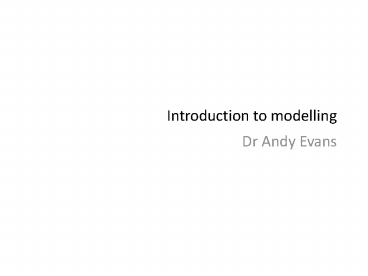Introduction to modelling PowerPoint PPT Presentation
Title: Introduction to modelling
1
Introduction to modelling
- Dr Andy Evans
2
What are models?
- Hypothetical or Theoretical statement of how a
system works, ignoring accidental influences. - Physical recreation of the same using scaled
objects and applying the same processes. - Computer recreation of the same using virtual
objects and applying virtual processes.
3
Why model?
- Prediction
- Future
- Past (backcasting)
- Testing our knowledge is complete.
- Emergence (how simple processes give us
complicated patterns) - Holding our knowledge in a framework.
4
Virtual model types
- Analytical models
- Mathematical equation.
- Logical
- Prolog models fuzzy logic etc.
- Iterative models
- Finite element models agent-based models
- Statistical models
- Regression equations Bayesian nets etc.
5
Verisimilitude
- Abstract models
- Simplified objects
- Subset of processes
- Thought experiments
- Verify that core processes are appropriate
- Alternative is to try and model everything
accurately. - Is this possible in systems that dont have
closure?
6
Model scale
- Aggregate models
- Regression
- Disaggregate models
- Range from area processing to individual-based
- Individual elements
- Finite-element models
- Agent-based models
7
Individual level modelling
- Aggregate representation was good when it all had
to be done in our heads. - Now we have power for individual representation,
i.e. as we understand the world. - We struggle to understand emergence how simple
rules of individuals end up in complicated system
behaviour.
8
Emergence
- May seem subjective (how to do recognise
complicated, why worry about other scales?) - But subjective aggregate elements have a big
effect (e.g. inflation rates affect interest
rates) - Systems of small scale elements that combine to
make large scale systems in unclear ways are
called complex. - Individual-level models are a useful way of
exploring complexity.
9
Modelling
- Identify interesting patterns
- Build a model of elements you think interact and
the processes / decide on variables - Verify model
- Optimise/Calibrate the model
- Validate the model/Visualisation
- Sensitivity testing
- Model exploration and prediction
- Prediction validation
PowerShow.com is a leading presentation sharing website. It has millions of presentations already uploaded and available with 1,000s more being uploaded by its users every day. Whatever your area of interest, here you’ll be able to find and view presentations you’ll love and possibly download. And, best of all, it is completely free and easy to use.
You might even have a presentation you’d like to share with others. If so, just upload it to PowerShow.com. We’ll convert it to an HTML5 slideshow that includes all the media types you’ve already added: audio, video, music, pictures, animations and transition effects. Then you can share it with your target audience as well as PowerShow.com’s millions of monthly visitors. And, again, it’s all free.
About the Developers
PowerShow.com is brought to you by CrystalGraphics, the award-winning developer and market-leading publisher of rich-media enhancement products for presentations. Our product offerings include millions of PowerPoint templates, diagrams, animated 3D characters and more.

